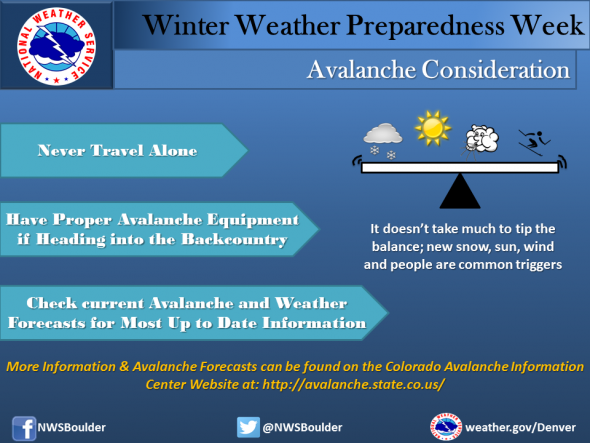
As snow starts to fall, many Coloradoans and out of state visitors will take advantage of it and head to the mountains for a variety of outdoor activities. Whether skiing, snowshoeing, or hiking, anyone who spends time outdoors in the high country needs to be aware of the danger avalanches present. On average six people die in Colorado every year from avalanches and being prepared is an essential survival skill.
In this fifth in a series on Winter Weather Preparedness from the National Weather Service, ThorntonWeather.com helps you understand avalanches, where they occur, how to protect yourself and where to go for more information. If you are headed to the high country, be sure to check out our Avalanche Information & Forecast page.
PUBLIC INFORMATION STATEMENT
NATIONAL WEATHER SERVICE DENVER CO
600 AM MDT FRI OCT 21 2022
Avalanches – Are you prepared?
Thousands of avalanches occur each winter in the mountains of Colorado. With the enormous popularity of winter sports in Colorado, this poses a risk to skiers, snowboarders, snowmobilers, and people traveling in the backcountry. On average 6 people die in Avalanches in the state of Colorado every year. Anyone who travels into the high country in the winter should be prepared for avalanches And know how to avoid them.
The most important thing to know is how to get information on current avalanche conditions. Check the Colorado Avalanche Information Center website at http://avalanche.state.co.us/ for the current avalanche forecast and the National Weather Service website http://www.weather.gov for the current weather forecast in your area. Knowing the current and future conditions will help you make good decisions in the backcountry.
Winter Weather Education Series
| Intro | Winter Weather Preparedness Week |
| Part 1 | Winter travel safety |
| Part 2 | Watches…warnings…and advisories |
| Part 3 | High winds |
| Part 4 | Wind chill temperatures and hypothermia |
| Part 5 | Avalanche safety |
| Review | Winter Weather Preparedness Week review |
A little information about avalanche safety can go a long way. Most avalanches occur during or just after snowstorms on a slopes between 30 to 45 degrees. A significant snowfall may result in an unstable snowpack. By waiting at least 36 hours after a big snow or wind storm before you go into the mountains the Snow may become more stable and less likely to avalanche. If you stay in valleys away from avalanche chutes, in stands of dense trees, or on gentle slopes you can decrease the risk of being caught in an avalanche.
If you are a skier or snowboarder at a commercial ski area the risk from avalanches is lower than in the backcountry. Ski patrols work to reduce the chance of an avalanche on open slopes. Respect the rules of the ski area, stay on open slopes, and do not stray out of bounds or into closed areas. The avalanche risk is higher outside of the ski area boundaries.
If you want to enjoy the great outdoors in areas prone to avalanches…You can reduce the danger by following a few simple rules:
- Check the current avalanche forecast to get information on current and forecast avalanche conditions. Also check the latest weather forecast to see if conditions are likely to change while you are in the backcountry.
- Never travel alone. Always have one or more companions. Even small avalanches can be fatal. If you are alone and get trapped, you may not be found until spring.
- If crossing a slope that may be prone to avalanches, do it one person at a time. You want to minimize the impact on your party if an avalanche is accidentally released.
- In avalanche country, all members of your party should carry avalanche rescue equipment including an avalanche beacon, shovel and probe pole. This increases your chances of a successful rescue and finding your friends alive.
Avalanche conditions in Colorado are monitored and forecasted by the Colorado Avalanche Information Center, CAIC. You can get more information on avalanches, avalanche forecasts, avalanchesafety and request a safety class from CAIC. Go to their website…Http://www.colorado.gov/avalanche or call the center at 303-499-9650.
Winter Weather Preparedness Week continues through Saturday. Now is the time to get prepared for winter so you can safely enjoy the outdoors and travel safely when the snow flies.


Great info for back-country skiiers. Thanks for posting it.